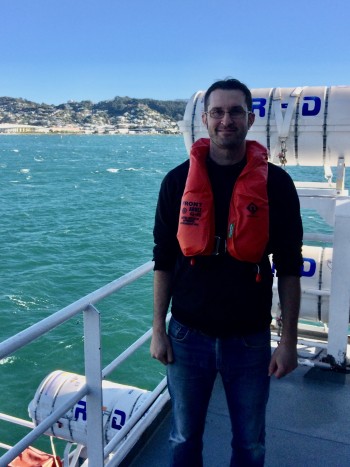 2024 McKay Hammer Award winner:
2024 McKay Hammer Award winner:
Dan Bassett
Dan's award recognises a sustained body of work that has significantly advanced our understanding of subduction zone structure and processes. Dan has led research on Hikurangi Margin crustal structure and the relationship between forearc structure and shallow megathrust slip behaviour.
At the same time Dan has collaborated with others on broader questions of intraplate volcanism and subduction zone slip behaviour.
Past McKay Hammer Award winners
| Year | Person | From | For publication(s) on |
| 2023 | Finn Illsley-Kemp | Victoria | His innovative and timely work on the seismicity associated with Taupō volcano. |
| 2022 | Jamie Howarth | Victoria | Calibrating the marine turbidite palaeoseismometer using the 2016 Kaikōura earthquake, and Spatiotemporal clustering of great earthquakes on a transform fault controlled by geometry. |
| 2021 | Joshu Mountjoy | NIWA | Earthquakes drive large-scale submarine canyon development and sediment supply to deep-ocean basins. |
| 2020 | Susan Ellis | GNS Science | For a body of work as a leading geodynamic modeller, making pivotal contributions to our understanding of tectonics. |
| 2019 | Ewan Fordyce | Otago | A new eomysticetid from Oligocene Kokoamu Greensand of New Zealand and a review of Eomysticetidae. |
| 2018 | Laura Wallace | GNS | For a body of work that has been transformative in our understanding of the seismic behaviour of the Hikurangi subduction margin. |
| 2017 | Daphne Lee | Otago | For a body of work on palaeontology and palaeobotany of southern Zealandia using fossils in Oligocene-Miocene sedimentary deposits. |
| Nicholas Golledge | Victoria | For a body of work on modelling the Antarctica Ice Sheet. | |
| 2016 | Helen Bostock | NIWA | For a body of work devoted largely to palaeoceanogrphy and palaeoclimatology in the New Zealand and wider Southern Hemisphere regions. |
| 2015 | Julie Rowland | Auckland | Hydrologic, magmatic, and tectonic controls on hydrothermal flow, Taupo Volcanic Zone, New Zealand: Implications for the formation of epithermal vein deposits. |
| 2014 | Kelvin Berryman | GNS | Major earthquakes occurring regularly on an isolated plate boundary fault. |
| 2013 | Bruce Hayward | Geomarine Research | The last global extinction (Mid-Pleistocene) of deep-sea benthic foraminifera. |
| 2012 | David Barrell | GNS | South Island glacial geomorphology and the record of climate change. |
| 2011 | David Lowe | Waikato | Tephrochronology. |
| 2010 | Simon Cox | GNS | Mapping and scientific contributions to understanding the geology of the Southern Alps, focussing on his work on the Aoraki QMAP project. |
| 2009 | Brent Alloway | Wellington | Tephrochronology and its application to palaeoenvironmental and palaeoclimatic reconstructions. |
| 2008 | Andy Nicol | GNS | Research on faults spanning the divide between seismology and structural geology. |
| 2007 | Alan Beu | GNS | Marine Mollusca of oxygen isotope stages of the last 2 million years in New Zealand |
| 2006 | Tim Naish | GNS | Plio-Pleistocene marine record of Wanganui Basin |
| 2005 | Chris Hollis | GNS | KT boundary environmental changes |
| 2004 | Phil Shane | Auckland | Tephrostratigraphy & paleoenvironments |
| 2003 | Tim Little | Victoria | Southern Alps & Neotectonics |
| 2002 | Peter Kamp | Waikato | Fission track thermochronology |
| 2001 | Pat Suggate | GNS | Quaternary stratigraphy & coal rank |
| 2000 | Chris Adams | GNS | Provenance of NZ terranes |
| 1999 | Phil Barnes | NIWA | Southern Hikurangi margin |
| 1998 | Lionel Carter | NIWA | Shelf to deep ocean processes |
| 1997 | James Crampton | GNS | Inoceramid taxonomy |
| 1996 | Peter Koons | Otago | Collision zones and processes |
| 1995 | Ian Wright | NIWA | Offshore TVZ volcanism |
| 1994 | Nick Mortimer | GNS | Otago Schist |
| 1993 | Brad Pillans | Victoria | NZ Quaternary geology |
| 1992 | Phil Maxwell | Waimate | Eocene macropaleontology |
| 1991 | Werner Giggenbach Jack Bradshaw |
DSIR Otago | Hydrothermal work; Fiordland petrology |
| 1990 | Cam Nelson | Waikato | Carbonate deposits |
| 1989 | Chuck Landis Clark Blake |
Otago & USGS | Tectonostratigraphic terranes |
| 1988 | Ian Turnbull | NZGS | Southland geology |
| 1987 | No award made | - | - |
| 1986 | Colin Wilson | Auckland | Taupo eruption |
| 1985 | Matt McGlone | DSIR Botany | Quaternary flora, climate |
| 1984 | Jarg Pettinga | Canterbury | Southern Hawkes Bay geology |
| 1983 | Mike Johnston | NZGS | East Nelson geology |
| 1982 | George Walker | Hawaii | Taupo ignimbrites |
| 1981 | Vince Neall | Massey | Taranaki volcanicity |
| 1980 | Roger Cooper | NZGS | Paleozoic geology and fauna |
| 1979 | Simon Nathan | NZGS | West Coast geology |
| 1978 | Bruce Hayward | NZGS | Waitakere Ranges geology |
| 1977 | Ian Speden | NZGS | Cretaceous geology |
| 1976 | Gordon Williams | Otago | Economic geology of NZ |
| 1973-74 | PB Andrews | Sedimentology, Torlesse and Otago shelf papers | |
| 1972-73 | No award made | ||
| 1971-72 | DG Bishop | Petrology and structural geology papers | |
| 1970-71 | DG Jenkins | Planktonic Foraminifera bulletin | |
| 1969-70 | T Hatherton | Geophysical anomalies and seismicity papers | |
| 1968-69 | GH Scott | Biometry in micropaleontology papers | |
| 1967-68 | R Stoneley | East coast decollement paper | |
| 1966-67 | JP Kennett | Kapitean stratigraphy papers | |
| 1966 | No award made | ||
| 1965 | A Ewart | Whakamaru Ignimbrite paper | |
| 1964 | JB Waterhouse | Permian brachiopoda bulletin | |
| 1963 | BL Wood | Structure of Otago schists paper | |
| 1962 | B Gunn and G Warren | Geology, Antarctica bulletin | |
| 1961 | N de B Hornibrook | Oamaru foraminifera bulletin | |
| 1960 | DS Coombs | Low grade mineral facies paper | |
| 1959 | HW Wellman | NZ Cretaceous divisions paper | |
| 1958 | M Gage | Glaciations, Waimakariri paper | |
| 1957 | CA Fleming | Pecten bulletin | |
| 1956 | GR Stevens | Geology of the Hutt Valley papers |
Alexander McKay

Alexander McKay was born in Scotland on 11 April 1841 and migrated to New Zealand aged 22.
After working in the New Zealand and Australian goldfields he spent four years exploring and prospecting the south-west part of the Mackenzie Country. It was during this time that he met Julius Haast who, in 1870, engaged him as an assistant on some geological surveys of the north Canterbury region.
Late in 1872 James Hector, director of the Colonial Museum and Geological Survey of New Zealand, noted McKay's fine saurian fossil collections from Waipara in the Canterbury Museum, and engaged the young geologist to make similar collections from Haumuri Bluff near Kaikoura. At the completion of this work in April 1873 McKay moved to Wellington. Shortly afterwards he was appointed a permanent officer in the Geological Survey, where he remained until retrenchment of the survey in 1892. He was then transferred to the Mines Department as mining geologist, eventually becoming government geologist.
Initially a fossil collector for the Geological Survey, McKay was soon sent by Hector on geological reconnaissance explorations. Enthusiasm, physical and mental robustness, and a sheer joy in discovery and exploration carried McKay to the remotest parts of the country. He delighted in the discovery of a new fossil locality, the rocking motion of an earthquake, and particularly, a finding in the field that cast doubt on the favoured theory of a local specialist.
In the late 1880s McKay took up a new enthusiasm – photography. He experimented with designs of cameras and telescopes and with telephotography and microphotography, even grinding his own lenses from bottle ends, and achieved good quality photo-micrographs of thin sections of rocks. He retired from the public service in 1904.
Philosophically, McKay's greatest achievement can be seen as freeing New Zealand earth scientists from the strictures of a European-based 'received wisdom', enabling them to see, interpret and report the uniqueness of New Zealand geology.
Alexander McKay died in Wellington in 1917.
A longer more detailed biography of Alexander McKay can be found in Te Ara.
